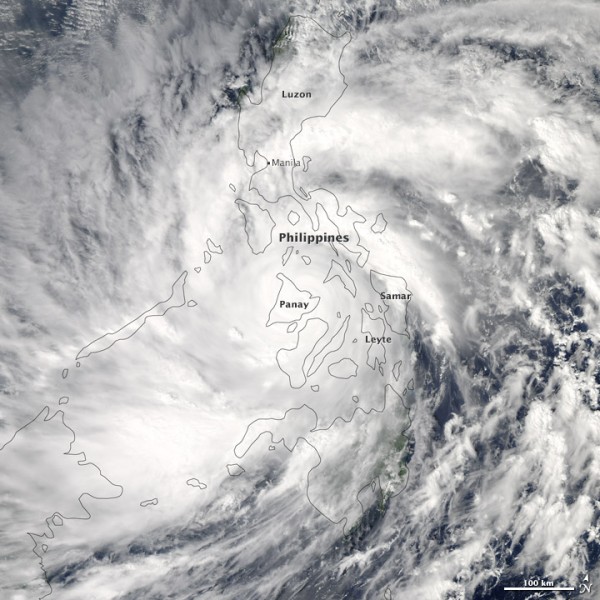By Ana Verayo, | September 06, 2016

The Moderate Resolution Imaging Spectroradiometer (MODIS) on NASA’s Aqua satellite acquired this natural color image of Super Typhoon Haiyan over the Philippines. The image was acquired at 2:10 p.m. local time (5:10 UTC) on November 8, 2013, when winds we
A new study has found out that typhoons that make landfall over Asia especially in Southeast Asia, are 15 percent stronger than those from the last four decades. Scientists reveal how the strongest typhoons or most category four or five typhoons have doubled, and even tripled ever since the late 1970s, due to warming ocean surface temperatures.
Like Us on Facebook
Typhoons can wreak havoc and destruction, causing massive structural damage to urban and residential areas and displacing ecosystems. One of the most recent events is Typhoon Haiyan that struck the Philippines in Southeast Asia, that killed more than 6,000 people in Tacloban, Leyte which is also one of the deadliest ever recorded, with winds ar 147 miles per hour that leveled the entire capital city of Leyte. It is also the third category five, super typhoon to reach landfall in the Philippines since 2010.
Scientists and climatologists have been recording and monitoring typhoon activity in the tropical region near the Pacific for ages, however, weather and typhoon patterns are changing faster in the past years, that it has been difficult to keep up with. Apart from this, record keeping only began in 1977, where data can be inconsistent based on the number of category four and five typhoons that hit the region since then.
In a new study by researchers from the Scripps Institution of Oceanography at the University of California, San Diego, scientists studied data to search for a pattern and establish better methods to obtain more accurate data when it comes to the occurrence of these powerful tropical typhoons.
New findings show how typhoons developed into more intense ones in the past 40 years, where typhoons that strike East and Southeastern Asia have become stronger by 12 to 15 percent, doubled and even tripling the number of category four to five typhoons.
Scientists blame that coastal waters are getting warmer, as sea surface temperatures play a crucial role in generating powerful storms, where this trend is also highly likely to continue, as global temperatures rise. They also add that greenhouse emissions are now warming up waters, intensifying typhoons hitting mainland China and Taiwan, Korea and Japan.
This new study is published in the journal, Nature Geoscience.
-
Use of Coronavirus Pandemic Drones Raises Privacy Concerns: Drones Spread Fear, Local Officials Say

-
Coronavirus Hampers The Delivery Of Lockheed Martin F-35 Stealth Fighters For 2020

-
Instagram Speeds Up Plans to Add Account Memorialization Feature Due to COVID-19 Deaths

-
NASA: Perseverance Plans to Bring 'Mars Rock' to Earth in 2031

-
600 Dead And 3,000 In The Hospital as Iranians Believed Drinking High-Concentrations of Alcohol Can Cure The Coronavirus

-
600 Dead And 3,000 In The Hospital as Iranians Believed Drinking High-Concentrations of Alcohol Can Cure The Coronavirus

-
COVID-19: Doctors, Nurses Use Virtual Reality to Learn New Skills in Treating Coronavirus Patients







